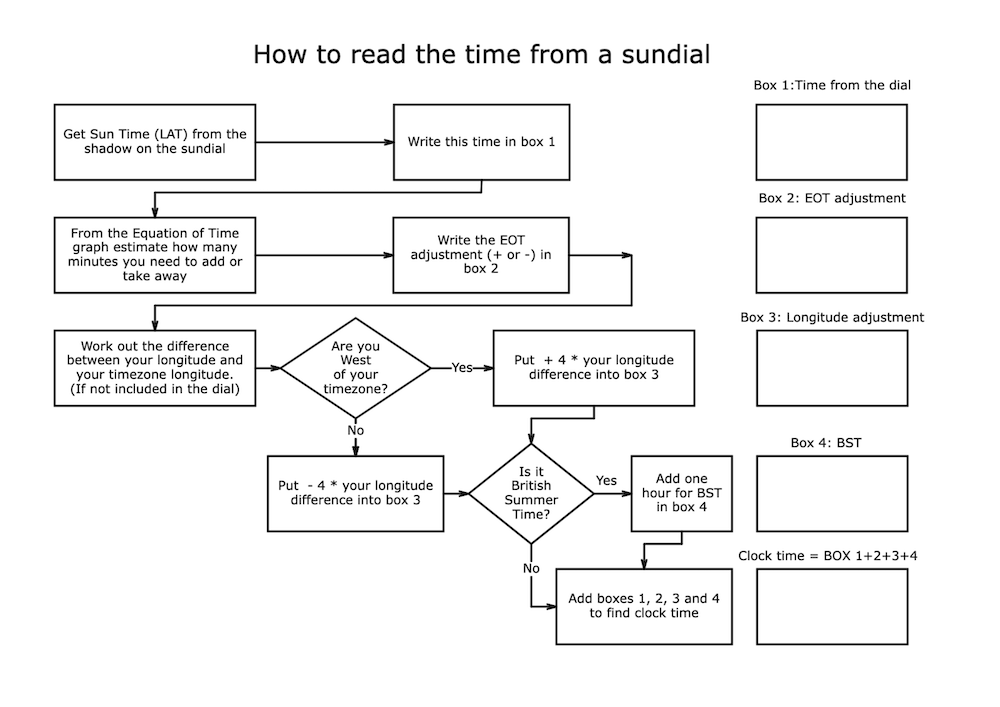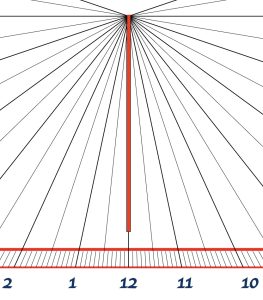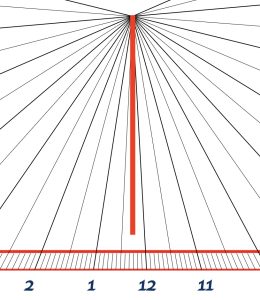- Home
- /
- All About Sundials
- /
- Reading a Sundial
Reading a Sundial
A sundial tells the time, but usually the time it shows won't agree with normal clock time. That is because the sundial measures a different sort of time.
To convert from 'Sun Time' – technically called 'Local Apparent Time (LAT)' or 'Local Apparent Sun Time (LAST)' – to 'Clock Time' follow these steps, using the Equation of Time graph here. The procedure is also shown in a flow chart below, and there are some worked examples too.
Step 1: Read the time from the sundial (LAT).
Step 2: Use the Equation of Time graph to find how much to add or subtract on this particular day.
Step 3: If your sundial is not already adjusted for longitude, work out how much to add or subtract for the difference in longitude between you and your time zone. (4 mins per degree, + for west, - for east). If you're not sure if has already been adjusted, see below. If you need to find your longitude, use the Latitude and Longitude Finder.
Step 4: add 1 hour if it is 'Summer Time' (BST/DST) - in the UK, from the end of March to end of October. Be aware that some sundials could be displaying BST - if 1 o'clock is in the centre, rather than 12, then this is probably the case, in which case you would subtract a hour if it is not BST.
You now have the 'Clock Time' shown by your sundial.
Equation of Time Graph

This diagram is also available as a printout (2 per page) for if you are doing this with a class.
Worked Examples
Example 1:
Say you are reading a sundial in Plymouth in the UK. The sundial should be set up for Plymouth's latitude of 50.37 North, and lets say it shows a time of 10:15, and the date is 15th of July.
Sun time (LAT) = 10:15
Look at the Equation of Time graph, in the middle of July and see that we need to add about 6 minutes.
Date adjusted time = 10:21
The longitude of Plymouth is 4.14 degrees West (call it 4) and in the UK we are in the GMT timezone, which is based on a longitude of zero. So Plymouth is 4 degrees West of its timezone, and we need to add 4 minutes for each degree, so plus 16 minutes.
Date & Longitude adjusted time = 10:37
Is it British Summer Time in July? Yes, it is, so add one hour.
BST, date & Longitude adjusted time = 11:37
This is the answer.
The sundial time of 10:15 equates to a clock time of 11:37 in Plymouth on 15th July.
The total correction for the sundial on this day is + 1 hour and 22 minutes.
Example 2:
Looking at a sundial in Dubrovnik in Croatia (latitude 46.2 North, longitude 18 East) which tells the time 14:25 on October 13th.
Sun time (LAT) = 14:25
Look at the Equation of Time graph. On the 13th of October (about 1/3 the way through October) we need to subtract about 14 minutes.
DST & Date adjusted time = 14:11
The longitude of Dubrovnik is 18 degrees East, and Croatia is in the Central European Timezone (CET) whose longitude is based on 15 degrees East. So Dubrovnik is 3 degrees East of its timezone. That means we need to subtract 4 minutes for each degree, giving us minus 12 minutes.
Date & Longitude adjusted time = 13:59
Is it Daylight Savings Time in Croatia? Yes, it is (until the end of October), so add 1 hour.
DST, Date & Longitude adjusted time = 14:59
The sundial time of 14:25 in Dubrovnik on the 13th of October equates to a clock time of 14:59.
The total correction for the sundial is + 34 minutes for this day.
Has the sundial been adjusted for longitude?
Often the longitude adjustment will be built into the sundial to save you having to work it out. It might say on the dial if it has, but if not, and the sundial is on a horizontal or vertical surface, here is how you can tell.
If the 12 o'clock line is in the middle of the dial, it has NOT been adjusted for longitude.

If the 12 o'clock line is off to one side of the middle, it HAS been adjusted for longitude.
